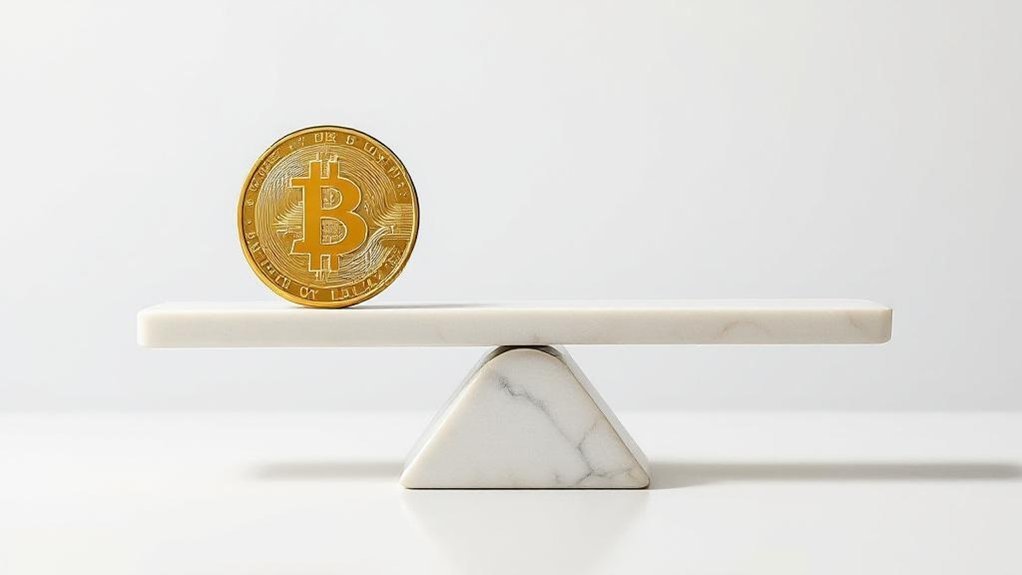A stablecoin is a digital currency that’s designed to stay steady, unlike the wild roller coaster ride of Bitcoin. It achieves this by anchoring its value to something reliable, usually the U.S. dollar or gold. Think of it as cryptocurrency’s sensible cousin – less exciting but way more practical for everyday use. While regular crypto bounces up and down like a kangaroo on caffeine, stablecoins aim to keep things boring and predictable. There’s a lot more to the story beneath this seemingly simple surface.

A stablecoin is cryptocurrency’s answer to volatility – a digital asset designed to maintain a steady value by pegging itself to something more reliable, like the U.S. dollar or gold. Think of it as the sensible cousin in the wild crypto family, the one who shows up to Thanksgiving dinner wearing a suit while Bitcoin’s doing backflips in the pool.
While Bitcoin plays cryptocurrency roulette, stablecoins keep their cool by anchoring themselves to reliable assets like good old-fashioned dollars.
These digital tokens come in several flavors, each with its own special sauce for maintaining stability. Software algorithms automatically adjust the supply based on market demand and prices.
The most straightforward are fiat-backed stablecoins like USDC and USDT, which keep actual dollars in reserve – you know, the old-fashioned paper stuff. Then there are the fancy crypto-backed versions like DAI, which use other cryptocurrencies as collateral, usually way more than necessary because, well, crypto prices are about as predictable as a cat on caffeine.
The crypto world desperately needed stablecoins. Without them, using cryptocurrency for everyday transactions would be like trying to buy coffee with stocks – nobody wants to spend Bitcoin when its value might double tomorrow.
Stablecoins bridge this gap, making it possible to actually use blockchain technology for normal things like payments and transfers. These digital assets are typically non-interest bearing investments, focusing on stability rather than returns.
But let’s be real – “stable” is a relative term here. While these coins aim to maintain their peg, they’re not exactly carved in stone.
They’re more stable than their volatile cousins, but they still carry risks. The mechanisms keeping them stable – whether it’s dollar reserves, crypto collateral, or algorithmic magic – can and do fail.
Just ask anyone who witnessed algorithmic stablecoins implode.
Despite their limitations, stablecoins serve vital roles in the cryptocurrency ecosystem. Blockchain-based services are increasingly incorporating these stable digital assets for various financial applications.
They’re the grease in the wheels of decentralized finance, enabling lending, borrowing, and trading.
They make cross-border payments faster and cheaper than traditional methods.
And perhaps most importantly, they give crypto users a way to park their value without completely exiting the digital asset world.
Not bad for cryptocurrency’s designated driver.
Frequently Asked Questions
How Secure Are Stablecoins Compared to Traditional Bank Deposits?
Stablecoins are generally less secure than traditional bank deposits. Period.
While both can maintain stable value, bank deposits come with FDIC insurance and regulatory protections – stablecoins don’t.
They’re vulnerable to runs if people lose confidence in the issuer.
Sure, stablecoins must keep reserves in safe assets, but without government backing or access to central bank support, they’re basically flying without a safety net.
Can Stablecoins Be Used for International Money Transfers Without Fees?
Completely fee-free stablecoin transfers? Not quite.
While substantially cheaper than traditional banks’ 3-5% fees, stablecoins still incur some costs. Network transaction fees (gas fees) are unavoidable. Plus, converting between fiat and stablecoins often involves exchange fees.
Still, international transfers using stablecoins typically cost just 0.1-0.3% – a fraction of traditional banking fees. And they’re lightning fast, settling in minutes instead of days.
What Happens to Stablecoins During a Crypto Market Crash?
During crypto market crashes, stablecoins face serious turbulence.
Investors often panic and flee from riskier stablecoins to safer ones – classic flight to safety behavior. Some coins lose their precious dollar peg, creating a domino effect.
The TerraUSD collapse was brutal, wiping out $3.5 billion.
Collateral backing matters big time; if it’s sketchy, investors bolt. Even the supposedly “stable” ones aren’t immune when things get ugly.
Are Stablecoins Regulated by Government Financial Authorities?
Stablecoins now face serious government oversight.
The U.S. Senate’s GENIUS Act of 2025 marks a major shift, requiring issuers to get federal or state approval. Previously, it was like the Wild West – minimal regulation and lots of risks.
Now? Strict rules about reserves, transparency, and who can issue stablecoins. Foreign issuers must meet U.S. standards to play ball.
The regulatory landscape is finally catching up.
Which Countries Currently Accept Stablecoins as Legal Tender?
None. Not a single country currently recognizes stablecoins as legal tender.
While El Salvador famously adopted Bitcoin as legal tender in 2021, stablecoins haven’t reached that status anywhere yet.
Several countries like Hong Kong, Singapore, and the UAE have created regulatory frameworks for stablecoins, but that’s different from making them legal tender.
They’re regulated – sure. Legal tender? Nope.
